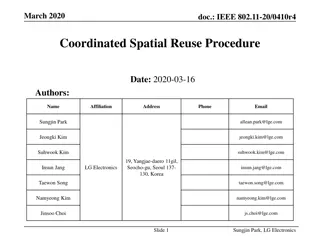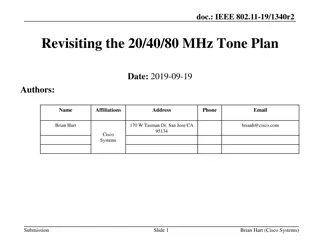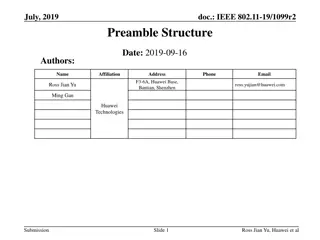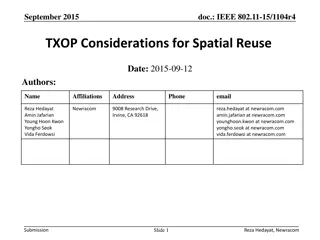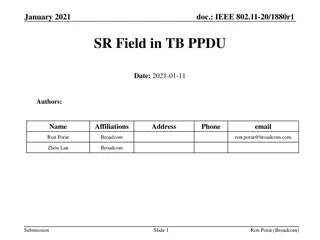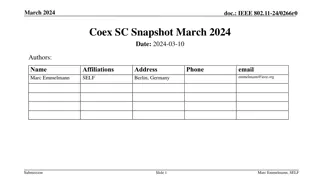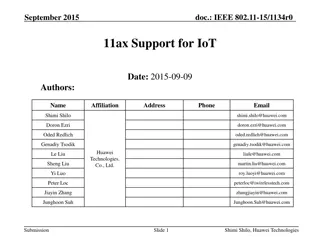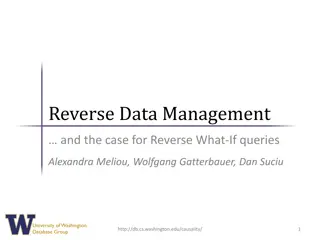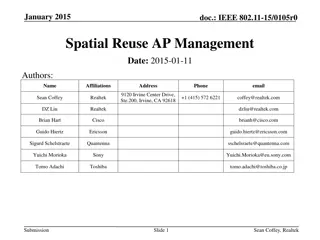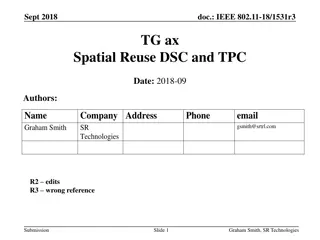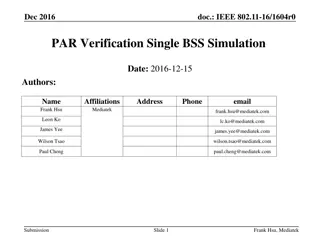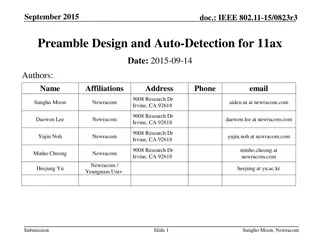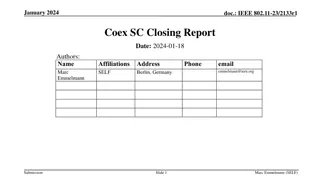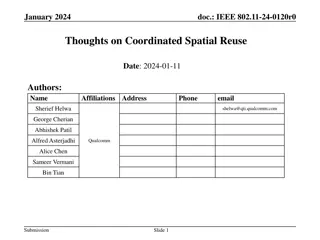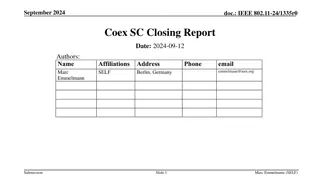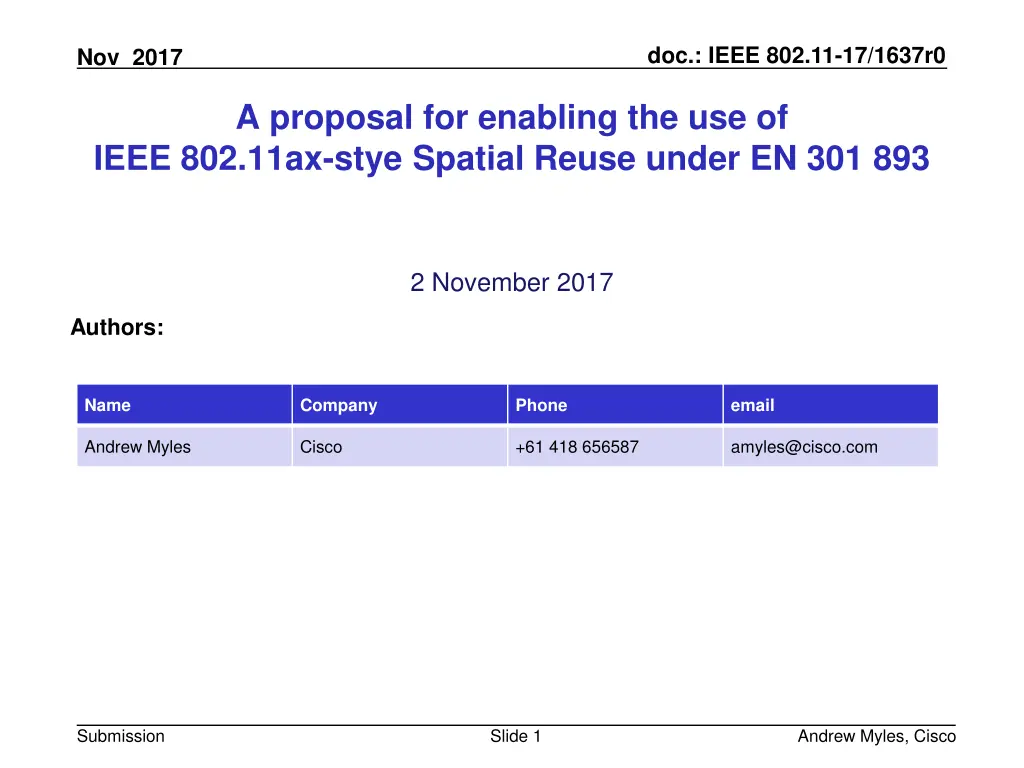
Proposal for Enabling IEEE 802.11ax-Style Spatial Reuse under ETSI BRAN Standard
This proposal focuses on refining the EN 301.893 ETSI BRAN standard to allow for the implementation of IEEE 802.11ax-style Spatial Reuse, in alignment with the goals of effective spectrum utilization and avoidance of harmful interference. The document outlines the challenges, assumptions, proposed solutions, and the need for revising the standard to accommodate the advancement towards efficient spatial reuse techniques. Various thresholds and methods are discussed in relation to conforming with regulatory requirements. The goal is to strike a balance between enabling innovation, maintaining technology neutrality, and minimizing complexity in implementing spatial reuse strategies.
Download Presentation

Please find below an Image/Link to download the presentation.
The content on the website is provided AS IS for your information and personal use only. It may not be sold, licensed, or shared on other websites without obtaining consent from the author. If you encounter any issues during the download, it is possible that the publisher has removed the file from their server.
You are allowed to download the files provided on this website for personal or commercial use, subject to the condition that they are used lawfully. All files are the property of their respective owners.
The content on the website is provided AS IS for your information and personal use only. It may not be sold, licensed, or shared on other websites without obtaining consent from the author.
E N D
Presentation Transcript
doc.: IEEE 802.11-17/1637r0 Nov 2017 A proposal for enabling the use of IEEE 802.11ax-stye Spatial Reuse under EN 301 893 2 November 2017 Authors: Name Company Phone email Andrew Myles Cisco +61 418 656587 amyles@cisco.com Submission Slide 1 Andrew Myles, Cisco
doc.: IEEE 802.11-17/1637r0 Nov 2017 EN 301 893 can be refined to allow 802.11ax-style SR with dual threshold EN 301 893 is an ETSI BRAN standard that provides a means of conforming to the R-ED requirements Situation Spatial reuse is a concept that well aligned with the efficient use goals of the RE-D EN 301 893 will need to be revised to enable 802.11ax-style SR Problem The challenge is to revise EN 301 893 in a way that balances 802.11ax-style SR against other goals Assumption One solution is for EN 301 893 to allow the potential victim of SR to decide if the medium is occupied ETSI BRAN agrees to 802.11 WG s request to enable dual threshold for 802.11ax A second variation is for a device to allow simultaneous transmissions within its own MCOT Answer The proposed SR rules enable innovation, maintain technology neutrality & minimise complexity Submission Slide 2 Andrew Myles, Cisco
doc.: IEEE 802.11-17/1637r0 Nov 2017 EN 301 893 is an ETSI BRAN standard that provides a means of conforming to the R-ED requirements EN 301 898 is a Harmonised Standard covering the essential requirements of article 3.2 of Directive 2014/53/EU Directive 2014/53/EU is also known as RE-D Article 3.2 of the RE-D encourages effective & efficient use of the spectrum and the avoidance of harmful interference Radio equipment shall be so constructed that it both effectively uses and supports the efficient use of radio spectrum in order to avoid harmful interference EN 301 893 has been developed & revised by ETSI BRAN over many years to allow one voluntary means of conforming to the essential requirements The current version of EN 301 893 is v2.1.1 and was ratified in May 2017 ETSI BRAN have just adopted a WI to revise EN 301 893 again, with the adaptivity clauses representing one significant focus Submission Slide 3 Andrew Myles, Cisco
doc.: IEEE 802.11-17/1637r0 Nov 2017 EN 301 893 defines two threshold methods to support the effective use goals of RE-D The adaptivity clauses in EN 301 893 v2.1.1 were mainly designed to encourage fair sharing of the 5GHz band by all technologies Fair sharing promotes effectiveuseof spectrum The sharing mechanism specified by the adaptivity clause is based on an LBT mechanism derived from 802.11 EDCA, using two threshold methods to determine whether the medium is busy Energy Detection threshold of -72 dBm (the threshold actually varies depending on tx power); OR Energy Detection threshold of -62 dBm, as long as the system is conformant with IEEE 802.11-2016 (including its Preamble Detection threshold of -82 dBm) The first method was included mainly for use by LTE based technologies, while the second method was included mainly for use by 802.11a/n/ac The current version of EN 301 893 specifies the first method must be used for any systems not conformant with IEEE 802.11-2016 Therefore, 802.11ax systems must currently use the first method Slide 4 Submission Andrew Myles, Cisco
doc.: IEEE 802.11-17/1637r0 Nov 2017 It is hoped the two threshold methods will enable fair sharing between 802.11 & LTE technologies The two threshold methods driving LBT in EN 301 893 represent a compromise hammered out in ETSI BRAN during 2015-16 by stakeholders from the Wi-Fi & LAA communities The two threshold methods may enable fair sharing between 802.11a/n/ac & LAA in at least some environments 3GPP simulations show fair sharing between LAA & 802.11ac in a number of specific scenarios, although the simulations have known flaws that have been noted by IEEE 802 in multiple LS s to 3GPP RAN1 It is likely both threshold methods, or refinements, will become the basis for some level of fair sharing between all technologies There are no proposals to fundamentally change EN 301 893 s LBT mechanism 802.11 WG has proposed that EN 301 893 be refined to allow any technology (incl 802.11ax) to use the second method (denoted the dual threshold method) Few 802.11ax/LTE technology coexistence simulations have been published but it is hoped the two threshold methods will enable some level of fair sharing Slide 5 Submission Andrew Myles, Cisco
doc.: IEEE 802.11-17/1637r0 Nov 2017 Spatial reuse is a concept that well aligned with the efficient use goals of the RE-D IEEE 802.11ax will include two spatial reuse (SR) mechanisms to enable some simultaneous transmissions by 802.11 in dense deployments OBSS_PD-based spatial reuse SRP-based spatial reuse SR, such as that proposed for 802.11ax, when designed and implemented well, should enable more efficient use of limited spectrum resources As such, SR is well aligned with R-ED Article 3.2, which encourages efficient use of spectrum Submission Slide 6 Andrew Myles, Cisco
doc.: IEEE 802.11-17/1637r0 Nov 2017 Assumption: ETSI BRAN agrees to 802.11 WG s request to enable dual threshold for 802.11ax IEEE 802.11 WG has requested ETSI BRAN to refine EN 301 893 to allow 802.11ax to use a dual threshold option similar to that specified in IEEE 802.11-2016 This proposal to enable 802.11ax-style SR is based on an assumption that that ETSI BRAN agrees to this request If ETSI BRAN do not agree to the request (thus forcing 802.11ax to use the single threshold option of ED = -72 dBm or less) then SR is enabled for ED less than -72 dBm 802.11ax may have less access to the medium than both 802.11ac and LAA in certain circumstances Submission Slide 7 Andrew Myles, Cisco
doc.: IEEE 802.11-17/1637r0 Nov 2017 EN 301 893 will need to be revised to enable 802.11ax-style SR The current version of EN 301 893 was specified with a bias towards ensuring fairness between systems (effective use) rather than efficiency Fairness between 802.11ac & LAA was the focus over the last two years SR was not considered in developing the current version of EN 301 893 However, the dual threshold mechanism will need some refinement to enable the use of 802.11ax-style SR Essentially, an exception to the PD = -82 dBm threshold is required to enable 802.11ax-style SR The challenge is to revise EN 301 893 in a way that balances 802.11ax- style SR against other goals Submission Slide 8 Andrew Myles, Cisco
doc.: IEEE 802.11-17/1637r0 Nov 2017 The challenge is to revise EN 301 893 in a way that balances 802.11ax-style SR against other goals Enable innovation Maintain fairness Minimise restrictive rules for SR in EN 301 893, thus enabling future innovation without needing to revise EN 301 893 again Develop rules for SR in EN 301 893 that maintains fair access for all technologies, similar to current version of EN 301 893 Goals for revising EN 301 893 to allow 802.11ax-style SR Support technology neutrality Limit complexity Rather than specifying technology-specific rules in EN 301 893, specify rules than can apply to any technology Refine EN 301 893 to allow SR in a way that focuses on general principles rather than relying on detailed & complex rules Submission Slide 9 Andrew Myles, Cisco
doc.: IEEE 802.11-17/1637r0 Nov 2017 One solution is for EN 301 893 to allow the potential victim of SR to decide if the medium is occupied One possible concept to enable SR in the context of EN 301 893 (and achieve the other goals on the previous page) is: A device may consider the medium to be not occupied if it has a reasonable basis to believe the current transmitter would consent to the device transmitting simultaneously One obvious reasonable basis would be if the device followed rules for SR that had been adopted by the transmitting device For example, if the device determined that the transmitting device was an 802.11 device (possibly by decoding the preamble and/or MAC header) then one could reasonably argue that simultaneous transmission was allowed in circumstances defined by the SR rules in 802.11ax There is no reason an LTE based systems could also not use this mechanism too Using this mechanism would probably require decoding preambles & possibly MAC headers Submission Slide 10 Andrew Myles, Cisco
doc.: IEEE 802.11-17/1637r0 Nov 2017 The proposed new rule in EN 301 893 increases the possibility of simultaneous transmissions The proposed new rule for enabling SR allows the medium to be considered not occupied if the transmitting device consents to simultaneous transmissions A device assuming the medium to be not occupied will allow the LBT mechanism to continue counting down and the device to transmit earlier than normal While this rule will enable simultaneous transmissions in many cases, it will not necessarily do so, depending on the state of the LBT countdown However, it is important to allow the LBT mechanism to continue operating as normal to avoid collisions between multiple other independent devices (a common situation in unlicensed spectrum) Submission Slide 11 Andrew Myles, Cisco
doc.: IEEE 802.11-17/1637r0 Nov 2017 A second variation is for a device to allow simultaneous transmissions within its own MCOT Discussions related to 3GPP NR-Unlicensed at a recent workshop suggest that these systems will often be coordinated & synchronised Therefore, these NR systems will not always need LBT to coordinate access and avoid collisions This observation suggests a second option should be introduced in EN 301 893 that allows immediate simultaneous transmission in some circumstances A device may transmit during an MCOT of the current transmitter if it has a reasonable basis to believe the current transmitter would consent to simultaneous transmissions While this proposed option was inspired by NR discussions, there is no reason future versions of 802.11 could not take advantage of this option too Submission Slide 12 Andrew Myles, Cisco
doc.: IEEE 802.11-17/1637r0 Nov 2017 The proposed SR rules enable innovation, maintain technology neutrality & minimise complexity The proposal is that EN 301 893 be modified to incorporate two rules to enable spatial reuse A device may consider the medium to be not occupied if it has a reasonable basis to believe the current transmitter would consent to simultaneous transmissions A device may transmit during an MCOT of the current transmitter if it has a reasonable basis to believe the current transmitter would consent to simultaneous transmissions These rules are conceptual; the actual text in EN 301 893 will depend on other refinements to EN 301 893 However, the proposed rules are sufficiently high level that they enable behaviour that supports the efficiency goals of EN 301 893 while also enabling future innovation in various standards, maintaining technology neutrality and minimising EN 301 893 complexity Submission Slide 13 Andrew Myles, Cisco
doc.: IEEE 802.11-17/1637r0 Nov 2017 The IEEE 802.11 Coexistence SC will discuss this proposed solution Questions Does 802.11 WG still want to promote the use of dual thresholds for 802.11ax? At least some would be happy for 802.11ax to use ED = -72 dBm at all times with no PD restrictions; this would resolve the SR issue but potentially cause fairness issues with 802.11ac and/or LAA Do we want to allow 802.11ax-style SR in a system that uses dual thresholds? Maybe it is sufficient to enable SR only in an environment that relies on ED = - 72 dBm Assuming we want SR with traditional dual thresholds: Are these proposed rules good enough to enable 802.11ax-style SR? Do these proposed rules have any unintended consequences? Submission Slide 14 Andrew Myles, Cisco

